How to Install Systemback on Debian, Ubuntu, Linux Mint
This tutorial will be showing you how to install Systemback on Debian, Ubuntu and Linux Mint. Systemback is a simple system backup and restore application, released under the terms of GPLv3 license. Features of Systemback includes:
- Create backups of the system and the users configuration files
- Restore the system to a previous state, just like the snapshot function of Virtualbox
- Create bootable ISO file from existing installation
- Copy the system from one partition to another partition.
- Upgrade software
Install Systemback on Debian 12, Ubuntu 24.04/22.04, and Linux Mint Desktop
Download the software packages.
wget https://repo.linuxbabe.com/pool/main/s/systemback/libsystemback_1.8.402_amd64.deb wget https://repo.linuxbabe.com/pool/main/s/systemback/systemback-cli_1.8.402_amd64.deb wget https://repo.linuxbabe.com/pool/main/s/systemback/systemback-efiboot-amd64_1.8.402_all.deb wget https://repo.linuxbabe.com/pool/main/s/systemback/systemback-locales_1.8.402_all.deb wget https://repo.linuxbabe.com/pool/main/s/systemback/systemback-scheduler_1.8.402_amd64.deb wget https://repo.linuxbabe.com/pool/main/s/systemback/systemback_1.8.402_amd64.deb
Install the packages.
sudo dpkg -i systemback*.deb
Then you can start Systemback from your application menu. You need to enter your password to use this software. After you enter the password, click OK button.
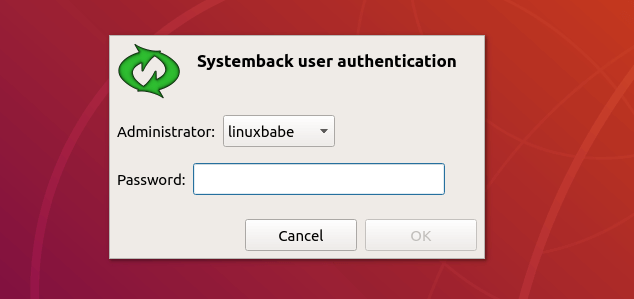
If you can’t start it from the application menu, then you can start it from command line with root.
Allow the root user to access X server.
xhost +local:
Switch to root. (Don’t omit the - character.)
sudo su -
Set the $DISPLAY environment variable.
export DISPLAY=:0.0
Start Systemback.
systemback
As you can see, you can create restore points of your system, restore to a point, copy the system to another partition, install the system to a new partition, create live system (bootable ISO image), repair the system and upgrade software on the system.
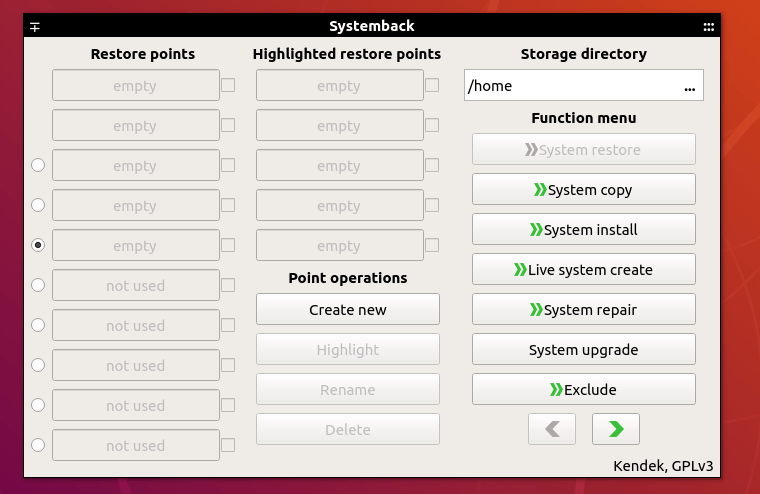
How to Create a Bootable ISO Image From Your Current System
Systemback can create a customized ISO image file from your current system. Every program and file can be included in the ISO.
Click the Live System Create button, then give a name to your ISO file. You have the option to include the user data files. Click the Create New button to create live system.
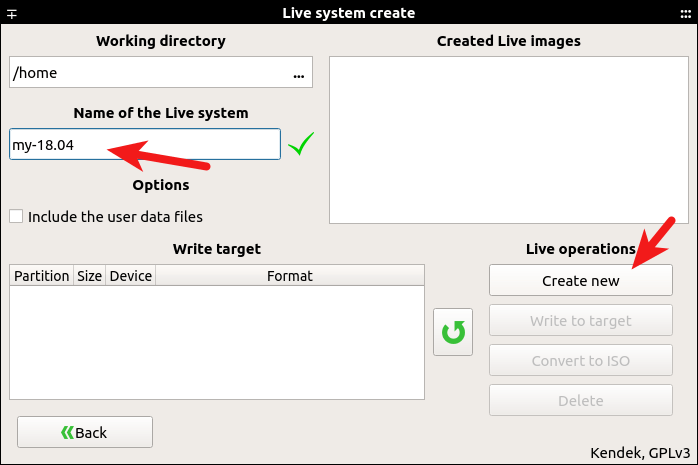
After the live system is created, you can convert the sblive file to ISO file. Note that if the sblive file is too big, you can’t convert it to ISO file. The sblive and ISO file are stored under your home directory by default, but they are not visible.
You can also insert your pen drive to your computer and write the sblive file to pen drive. (Click the reload button to detect USB drives.)
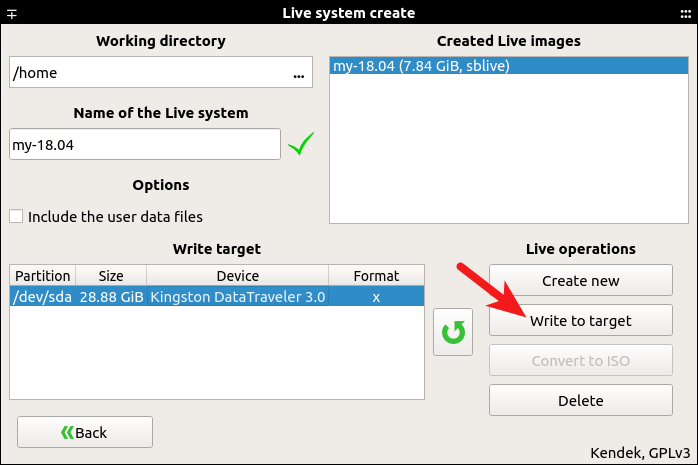
Because my system has many programs and files, this process can take some time.
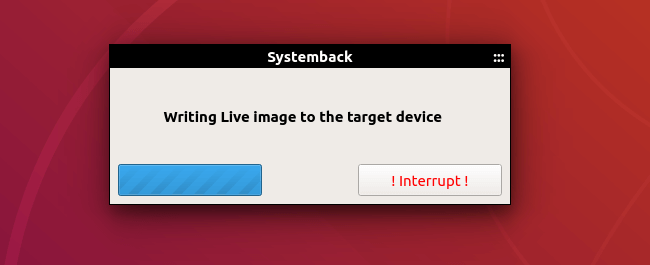
Once it’s done, you can use the bootable USB to install your customized Ubuntu system on other computers.
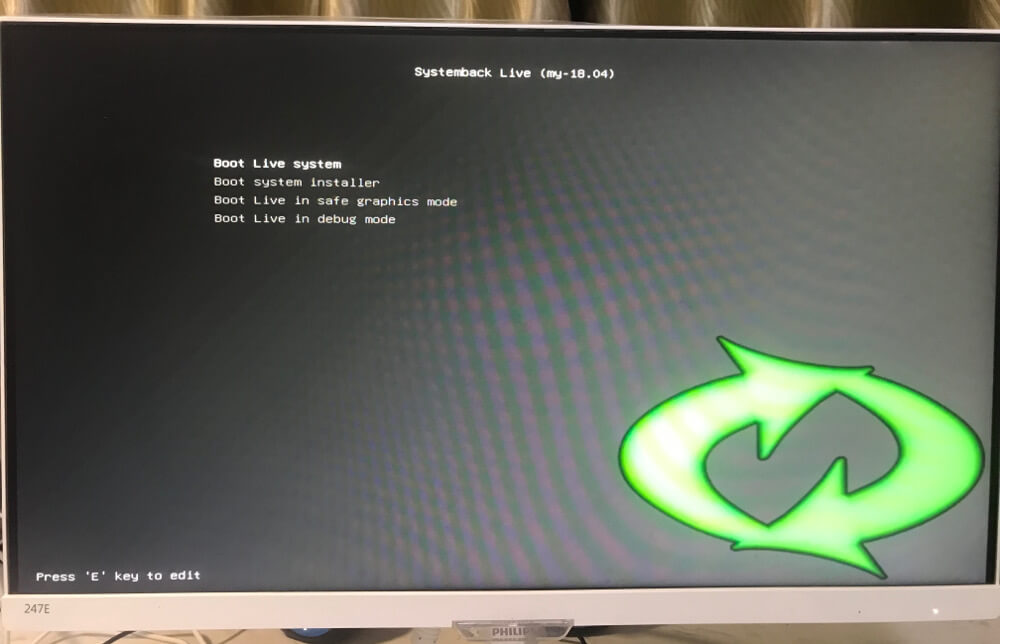
Select Boot system installer, then open systemback and click the system install button.
Systemback Config File
The config file is located at /etc/systemback/systemback.conf. You can configure it to automatically create live ISO image, change working directory/storage directory, enable XZ compression, etc.
How to Load the Entire Live System to RAM?
Linux live system has a nice feature called toram that allows you to load the entire live system into RAM. We all know RAM is way faster than SSD, so your system will run much faster. But make sure your computer has enough RAM to hold the entire file system. I have 48GB RAM on my desktop computer. To check if your RAM can accomodate the whole file system, simply compare the size of RAM and the filesystem.squashfs file on the USB stick. SquashFS is a compressed read-only file system for Linux. It efficiently compressed my 31GB Linux installation to a 15GB filesystem.squashfs file.
So when you boot your computer from USB drive, press E at the boot menu to edit the Linux boot command. Find the line that starts with linux and replace quiet splash with toram. Then press F10 to boot.

After that, it will begin the process of copying the live media to RAM.
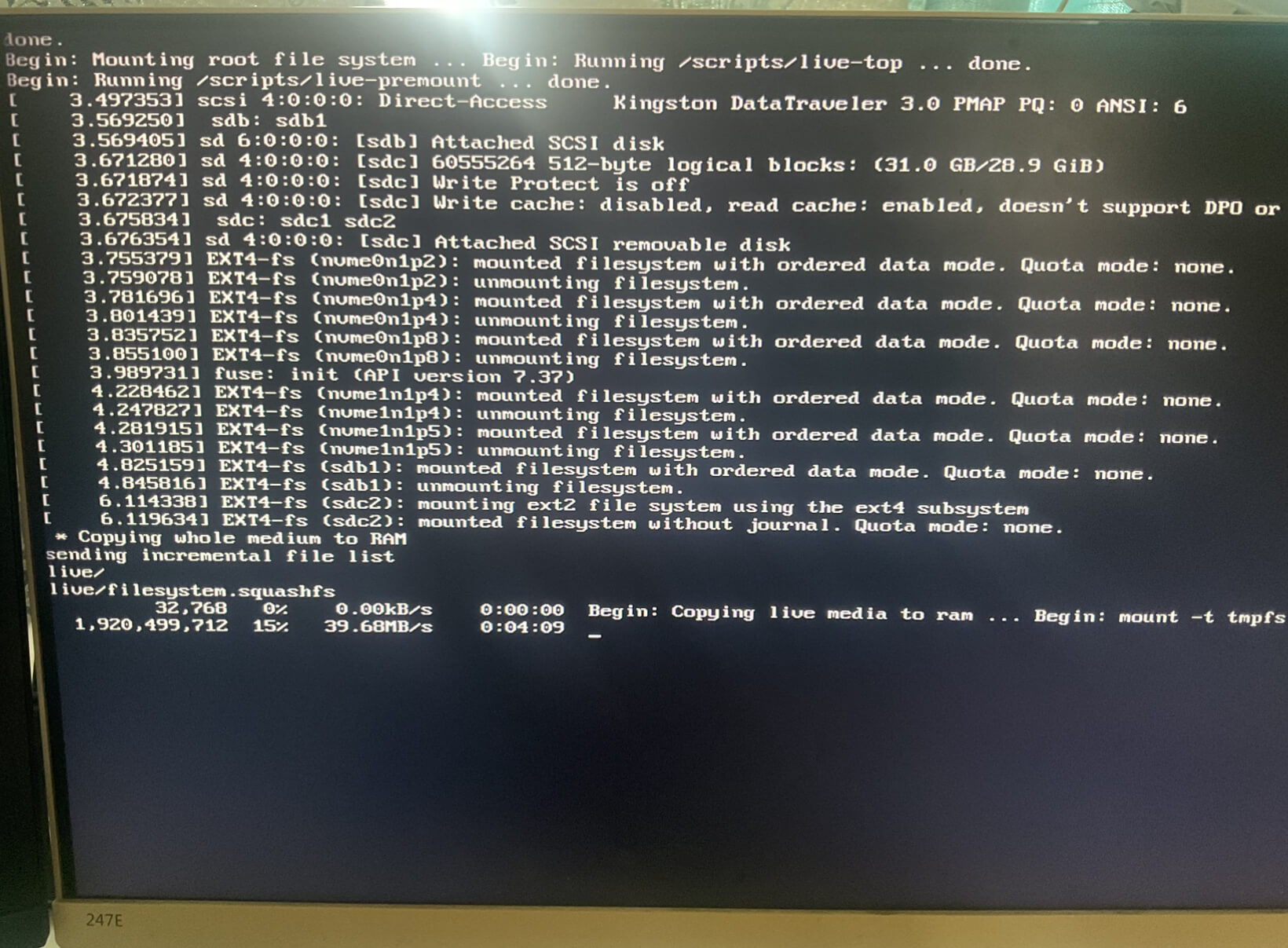
Once it’s finished, you can remove your USB stick from your computer and the system will run without problems, because the entire file system is in RAM.
USB stick is still slow when copying the live system to RAM. I have two NVME SSDs on my computer, so nowadays I use one of the SSD to create the Systemback bootable drive. It can copy the live system to RAM at 1.37GB/s speed.
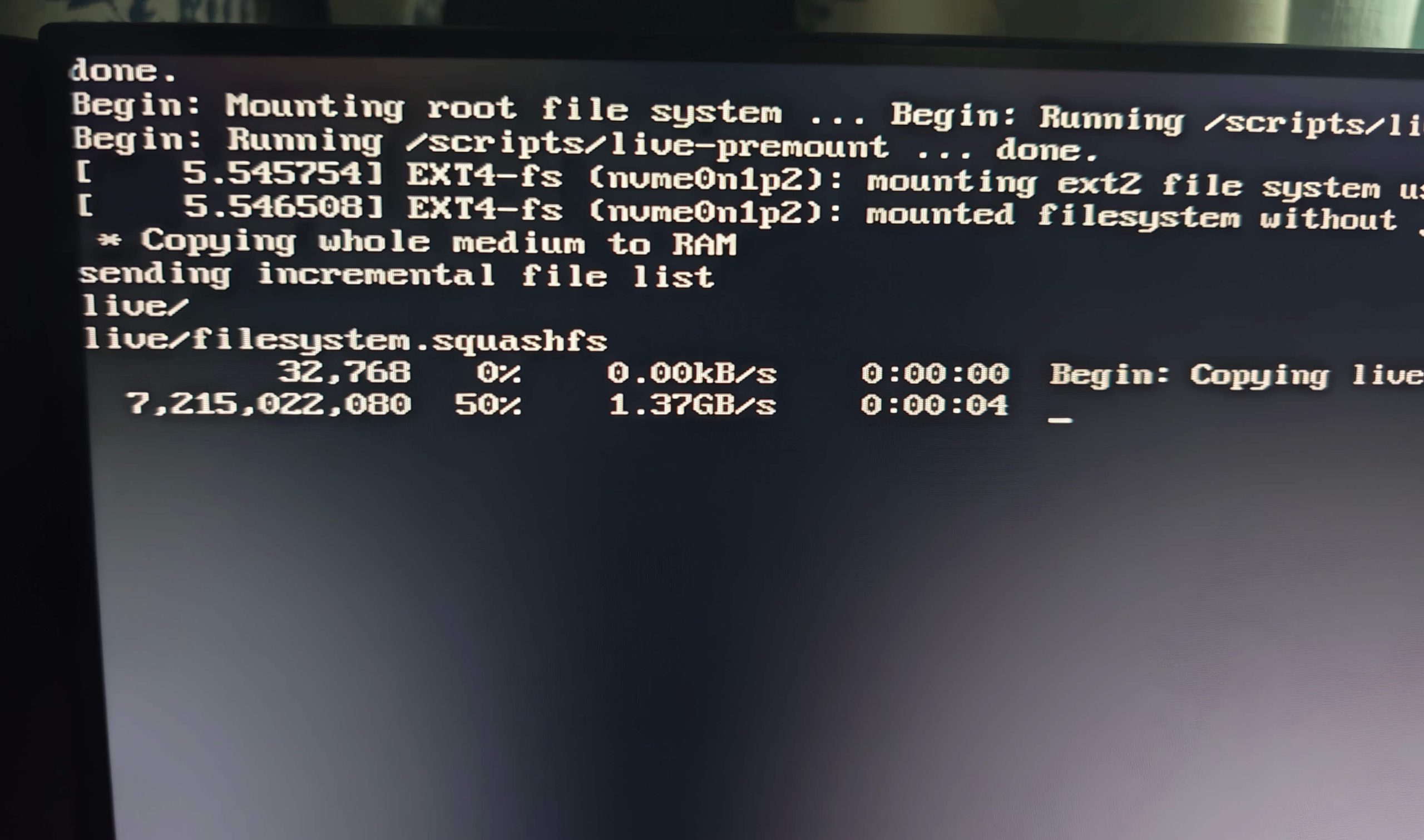
The live system is very speedy in RAM. I even noticed the Internet speed becomes faster.
What are some other benefits of running the system in RAM?
- SSD wearout is reduced and life span is greatly increased.
- If your system is infected by virus, simply reboot the computer, and the virus is gone.
- Normally every operating system becomes bloated over time. Eventually, you need to reinstall the OS to start from a clean state. You can avoid this headache by running the system in RAM.
- Longer lifespan for the computer. My desktop computer was built in 2017, but it feels like brand new when running the OS in RAM, thanks to its ludicrous speed. I think I can use it for 10 more years as a daily driver, while the average lifespan of a computer ranges from 3 to 8 years.
Install all the software you need on the original system, then use Systemback to create a live system out from it, and run it in RAM. It’s a perfect combination. I rarely shut down my computer. It costs a little electricity to suspend the system instead of shutting it down.
To gauge the lifespan of your SSD, install the smartmontools.
sudo apt install smartmontools
Then run the following command to check SMART/Health information. Replace /dev/nvme0n1 with the device name of your SSD.
sudo smartctl -a /dev/nvme0n1
On my old SSD (purchased in 2017), the Percentage Used value is 11%, which means this SSD has 89% lifespan left. I installed several Linux distributions on this SSD and used it almost every day over the past 7 years. If I continue to use it this way, it would take about 56 years for this SSD to fail completely.
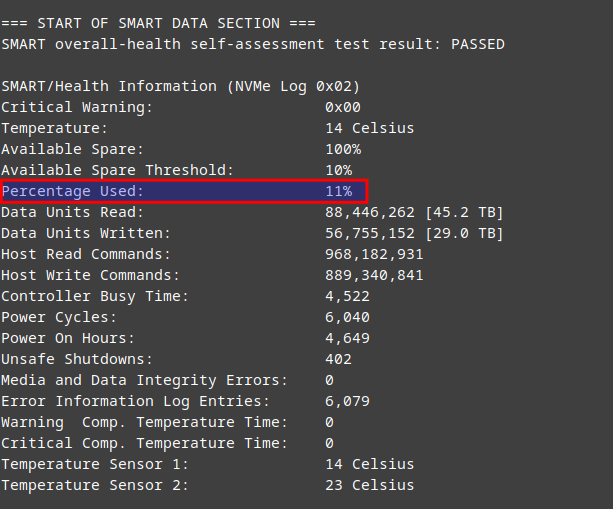
Backing Up Individual Files and Directories
Systemback is designed to back up the entire system. If you want to back up individual files and directories, then you can use a tool like Duplicati to automatically back up your files to cloud storage. Duplicati can encrypt your files to prevent prying eyes.
Run Systemback on a Linux Server Without GUI
Systemback has a command line interface (sudo systemback-cli), but it’s very limited in what it can do. It only allows you to create restore points. You can’t create a live ISO file. Luckily, you can run Systemback GUI interface on a Linux server without having to install a full-blown desktop environment. Here’s how.
Install an X window system and basic video driver. Xinit allows you to run a GUI program in X window system, without having to start a window manager or a full desktop environment.
sudo apt install xinit xterm xserver-xorg-video-fbdev libvdpau-va-gl1 xserver-xorg-video-qxl
Create a systemd service unit with a command-line text editor like Nano.
sudo nano /etc/systemd/system/systemback.service
Add the following lines to the file.
[Unit] Description=Systemback After=multi-user.target [Service] Type=simple Environment=HOME=/root ExecStart=/usr/bin/xinit /usr/bin/systemback Restart=always RestartSec=2 [Install] WantedBy=multi-user.target
Save and close the file. Then enable auto-start at boot time.
sudo systemctl enable systemback.service
Start it now.
sudo systemctl start systemback.service
Check status. Make sure it’s active (running).
sudo systemctl status systemback
If your Linux server runs on the cloud, you can access the Systemback graphical interface via VNC. Most VPS providers offer a web-based VNC console, so you can use it without installing VNC client software on your local computer.
The following screenshot shows the web-based VNC console for my Kamatera VPS. I can use my mouse to click on the various menu to easily make a full backup of the server.

If your VPS provider doesn’t offer a web-based VNC console, then you can use Apache Guacamole to set it up. But on the other hand, it’s a good idea to migrate to a better VPS provider.
Please note that it will use lots of CPU and RAM resources to create live ISO file. Make sure your server has enough RAM. You might want to stop some services before creating the ISO file to prevent the out-of-memory problem.
Use SSH X Forwarding to Run Graphical Programs on Headless Server
If your hosting provider doesn’t offer a web-based VNC console, you can also use SSH X Forwarding to run Systemback on the headless server without having to install a graphical desktop environment. The graphical application will use the X server of your local computer. Note: Your local computer must run an X server for this to work.
Edit the SSH server config file.
sudo nano /etc/ssh/sshd_config
Find the following lines.
X11Forwarding yes #X11DisplayOffset 10 #X11UseLocalhost yes
Change them to
X11Forwarding yes X11DisplayOffset 10 X11UseLocalhost no
Save and close the file. Then install xauth.
sudo apt install xauth
Restart SSH server.
sudo systemctl restart ssh
Edit the SSH client config file on your local computer.
sudo nano /etc/ssh/ssh_config
Find the following lines.
# ForwardAgent no # ForwardX11 no
Change them to:
ForwardAgent yes ForwardX11 yes
Save and close the file. Next, SSH into the server with -X flag. You must log in as root, because Systemback needs to run as root.
ssh -X root@12.34.56.78
Once you are logged in, run the following command to start Systemback.
systemback
The application window will appear on your local computer screen because it uses the X server of your local computer. If the latency is very high, then it might take a while for it to display on your computer screen.
Recommended reading: 5 Effective Tips to Harden SSH Server on Ubuntu
Wrapping Up
I hope this tutorial helped you install Systemback on Ubuntu 22.04 and 20.04. As always, if you found this post useful, then subscribe to our free newsletter to get more tips and tricks. Take care 🙂



Excellent service! This worked without problems on both my computers. Thanks Xiao, Happy Christmas and New year.
…sorry,
my system : Ubuntu Studio 22.10 Xfce
thx
rolw
Ubuntu 22.10 is also supported.
great tutorial, i love it!!! ty so much 🙂
Thank you so much!
It’s a relief to have it back!
When you specify an Ubuntu version does this mean it won’t work on newer versions? This is the absolute best Ubuntu help anywhere. You are a wizard! Love it and will donate!!
I don’t use systemback anymore. I found TimeShift. A much easyer app to use. You can find it in you software shop.
Thank you so much!
Realy great work!
After creating my liveUSB with Systemback, I’m successfully able to run the system from the USB.
But when I attempt the System-Install of my distro my “Partition Settings” table only shows the partition of the liveUSB. None of the rest of my partitions are visible.
Awesome, Can’t thank you enough for all of your help.
SASJ
Install libqt5gui5 with Synaptic in your system, libqt5gui5 is present but not standard installed
Will this also apply to Debian 10 buster?
Has anyone tested it already?
Hi. Yes, it applies to Debian 10 Buster as well.
Seems a great solution. Would be awesome if the software could get supported from some Open source community or get official in the Ubuntu community as I think is a great tool potentially save hours in case of any system crash after a new drivers( as recently happened to me).
Much obliged. With this software i can have my desktop os on the usb drive no matter whenever i’am at the point. God bless you.
Here, Linux MInt 19.2 (Tina) , and SystemBack Working Fine! 🙂
Tk’s and Congrat’s!
Y’re the Best!
systemback is not actually dead it seems.
https://gitlab.com/Kendek/systemback
Cannot start the Systemback graphical user interface!
Unable to get root permissions.
You can start it from command line with root. (Don’t omit the – character.)
Set the $DISPLAY environment variable.
Start Systemback.
I have the same problem on Ubuntu 24.04
The command line gives this error:
“Authorization required, but no authorization protocol specified
qt.qpa.xcb: could not connect to display :0.0”
Thanks, that worked on Linux Mint 19.3 after going into Software Sources/Maintenance and updating keys.
Thank you very much, it’s work. Nice share
although I got it installed on 20.04 the live system image creation is taking a very long time and no further sign of any change in the progress bar, as yet. Using htop with a filter (f5) to show only systemback processes does show activity. The folder /home/Systemback doesn’t yet have anything in it. Just think the gtk dialog box needs to be a bit more informative to show in more detail what it is doing. We’ll see whether it does anything…
Irre!
Super!
Endgeil!……
………
Eine Frage allerdings bleibt, spielt dann systemback auch malware auf?
Danke!
Interessant waere auch, wie sowas manuell geht.
Danke nochmal!
I am getting initramfs image error when trying to create the image. Ran through all the known troubleshooting with still no success any idea what be my issue?
Thanks
1 – Install ‘live-boot’
2 – then remove ‘casper’
3 – problem should be solved.
note:-
4 – Any iso you already have WILL still boot onwards by carrying out the following:-
1 – press ‘enter’
2 – enter ‘ctl-d’
solved!
Seriously, hope it helped.
Nice tutorial, bookmarked..!
But take a look at my response to “David” above; The actions I describe are a must for 18.04 onwards, or you will end up wit an iso that can only be ‘forced’ to boot in the way I describe as an ‘addenda’ fro David.
Best wishes,
matafile
I start Systemback with:
But got error:
Thanks so much. Playing with Ubuntu is a new and rewarding experience. Want to migrate away from Windows.
You should not run it with sudo.
Switch to root and start Systemback. (Don’t omit the – character.)
Set the $DISPLAY environment variable.
Start Systemback.
I tried to run it as root, but got error:
Please Set the $DISPLAY environment variable after switching to root.
ok up to this point no idea what to do next
Reading state information... Done Some packages could not be installed. This may mean that you have requested an impossible situation or if you are using the unstable distribution that some required packages have not yet been created or been moved out of Incoming. The following information may help to resolve the situation: The following packages have unmet dependencies: systemback : Depends: casper but it is not installable or live-boot but it is not installable Depends: syslinux ( 3:6) but it is not installable Depends: syslinux ( 3:6) but it is not installable Recommends: grub-efi-amd64-bin but it is not installable Recommends: lupin-casper but it is not installable Recommends: systemback-cli (= 1.8.402) but it is not going to be installed Recommends: systemback-locales (= 1.8.402) but it is not going to be installed E: Unable to correct problems, you have held broken packages.Try manually installing these dependencies with:
Then install systemback.
Questo tutorial funziona anche su Ubuntu 20.04 (Does this tutorial also work on Ubuntu 20.04)?
Grazie.
Ciao.
Thanks so much for this well covered and thoughtful tutorial. Also, LOL to the name sblive.
Systemback for Ubuntu 18.04…? Please
i installed system-back from your ppa and made an image used multi-system to write it to an sd card , i have installed it several times with out problem till now, one of the computers after install . i updated the computer kernel update it printed ( initramfs-tools is disabled since running on read only media ) this is a hard drive in a laptop not a usb drive. linux-image-5.3.0-51-generic was the kernel i was trying to update to. i ended up reinstalling it twice then when i could not get past, ( initramfs-tools is disabled since running on read only media )
i dropped back to 18.04.3.iso installed image from ubuntu and it installed and updated to linux-image-5.3.0-51-generic
my question is how and why initramfs-tools is saying read only media , i would think there is a file some where that could be changed to get around this .
i have installed it on ubuntu-mate 20.04 install went fine, it made the image fine, i wrote it to a usb key and installed it on a laptop every thing seems good , i will have to make sure the problem doesn’t persist with initramfs-tools is disabled since running on read only media.
Works great.
It works on my linux Lubuntu 20.04 lts !
Hi, I have used the option of system-back to convert the file to .iso, and it went onto the usb, but when I try to boot it gives an error saying “this is not a typewriter” and other messages I don’t understand.
I am using Peppermint Eight.
Any ideas?
MTIA
Hi guyz & girlz,
I have had installation failures related to remastersys failing to format an USB key correctly
the remedy is to format the USB device in EXT2 format before starting usb installation….
also, check you have ubiquity-frontend-gtk installed….
good luck !
I keep getting:
But nothing that I’m aware of is happening in the file system.
Dear brothers..
I am using it with Ubuntu Mate 20.04.2 and no problems appeared so far. I love it.
thank you bro, your writing helps my assignment
Works fine in Linux Mint Mate 20.3 as per your instructions.
Followed your instructions and everything loaded ok – no errors.
Thank you keeping this program going.
I’m sure everyone out there is very grateful.
The repository ‘https://repo.linuxbabe.com bullseye InRelease’ is not signed.
N: Updating from such a repository can’t be done securely, and is therefore disabled by default.
I’ve no doubt this does everything claimed. But timeshift is system supported and does it’s thing with no intervention on my part after initial setup. User data is kept up to date using using lucky backup and external media. Occasionally I run a system backup and am now using ‘redo’. The point is just as we have numerous Linux distributions, we also have many backup programs. For me, only one of each is needed, but to each his own. But do keep a backup of everything, things can and do go wrong. Love Linux and the support blogs, even my technically challenged wife is happily using it.
Thank you for publishing this message, I didn’t know something like this existed. After the weekend, I will have a go at running this program and if it is as good as it seems, I will be happy to donate. I am running Ubuntu 22.10 so I hope it works with this distribution. Many thanks for your work.
Rod. J.
Ubuntu 22.04…. tried all notes above and still get:
Before switching to root, run
I used this to create a backup of my system. I had to run as root from the terminal but overall it worked and I was able to clone my system to a different pc (from a Dell G15 to a Lenovo T450s and overall this did what it was supposed to do. Overall very happy
Hello,
Facing a problem to launch systemback app from 22.04
Hi there great tutorial and tool.. thanks for your efforts
Status:
I am on Ubuntu 20.04 Desktop and I can can successfully start and run systemback as the root user.
Problems:
On every boot I receive this error message:
I have check the systemd directories and no such daemons exist. can you tell me how to create them? Or How to get rid of this message?
Other Problem:
I also get a permissions error if I try to start Systemback as non-root user due a permissions error, instead of being prompted to enter a password. Any ideas?
Thanks
Hey there… update:
Did some more snooping… all ubuntu states that the systemback-scheduler is installed, in reality it is not installed:
The systemback systemd service files do not exist. I tried purging systemback from my ubuntu and reinstalling, but same result.
Any advice?
I am having the same problem-
“Unable to get root permissions”
seems to be a problem with the repo packaging :-/
hi, it doesn’t work on debian i386
in the installation
Your origin cert is expired. As such, cloudflare is denying access to your signing key and this entire process is now useless…Please update.
Thanks for telling me. The certificate has been renewed. You should be able to use it to install Systemback now.
when i execute sudo apt install systemback
Unable to locate package systemback with ubuntu 22.04 desktop
It works in Debian. I was trying to see if it works with LinuxMint but it do not work, it is installed and it ‘copy’ the system, I can see the options with the systemback logos … but I’m not able to open it when i click … got a black screen with some information of errors …
“but it is not going to be installed” (?) — I heard that they support ‘Timeshift’
so i think nobody in Mint care about Systemback (?):
# LANG=C apt install systemback
Reading package lists… Done
Building dependency tree… Done
Reading state information… Done
Some packages could not be installed. This may mean that you have
requested an impossible situation or if you are using the unstable
distribution that some required packages have not yet been created
or been moved out of Incoming.
The following information may help to resolve the situation:
The following packages have unmet dependencies:
systemback : Depends: libsystemback (= 1.8.402) but 1.9.4 is to be installed
Depends: systemback-scheduler (= 1.8.402) but it is not going to be installed
Recommends: lupin-casper but it is not installable
Recommends: systemback-cli (= 1.8.402) but it is not going to be installed
Recommends: systemback-locales (= 1.8.402) but it is not going to be installed
Recommends: ttf-ubuntu-font-family but it is not installable
E: Unable to correct problems, you have held broken packages.
root@kaos-Inspiron-3583:~#
Very sad, this is very nice tools!!.
I’ve been using Systemback to create ISO files for a family-friendly (web-filtered) Debian Stable-based respin I’ve made called F3OS (available with Xfce or Openbox, with plans for other desktop environments when I get around to it). However, someone recently complained that because it didn’t automatically log in, they felt they couldn’t use it. I E-mailed them back and gave them the login and password credentials to log in, which I DID put on the project website, but I never heard back from them — I’m gonna guess they ignored me and want to just trash and belittle my work. In response, I did also put the login information on more pages on the website, including the home page.
Therefore, in an attempt to make this idiot-proof, does anyone know if there’s a way to have Systemback make the ISO file one that automatically logs in when booted up?
I’m trying to install this on Linux Mint Cinnamon 21.3, however I cannot get it to recognize the repository as signed (signature is invalid even though I’ve run the wget command for the public key). Updating cannot be done securely so is therefore disabled during sudo-apt-update. Any thoughts?
I’m trying to install systemback, but it seems your key has expired!
Could you please publish a new key or let me know how else I can download this?
Output of sudo dpkg -i systemback*.deb:
PS: This was on a fresh installation of Ubuntu 22.04
Just got the same problem as you on Mint 21.3